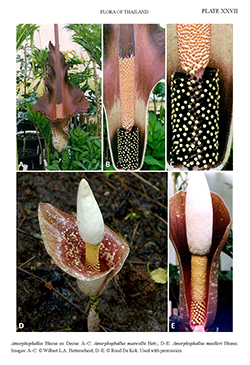e-Flora of Thailand
Volume 11 > Part 2 > Year 2012 > Page 162 > Araceae > Amorphophallus
31. Amorphophallus maxwellii Hett.
Blumea 39(1–2): 263. 1994. Plate XXVII: A–C.
Accepted Name : This is currently accepted.
Description : Tuber subglobose to depressed globose, ca 10–23 by 12–14 cm long, exterior distinctly glossy. Leaf solitary; petiole to 160 cm by 9 cm, smooth, whitish with large, steel-green spots, these with a clear lower margin and a fuzzy upper margin; leaf blade to 250 cm diam., rachises winged distally from the main basal branchings; leaflets elliptic to elongate-elliptic, to ca 16 by 7 cm, acuminate. Inflorescence long pedunculate; peduncle smooth, 18–100 by 1–3.5 cm, silvery white with large, irregular, dark steel-green spots; spathe subcampanulate, broadly ovate to elongate-elliptic, 27–69 by 13–32 cm, base and limb separated by a very shallow constriction, base convolute and slightly laterally compressed, limb at first oblique then the upper part strongly arching forward, apex acute, margins strongly sinuous and folded, limb exterior lower half pale cream or pink with dull violet stains, upper half very dark maroon, interior lower half cream or purple, upper half very glossy dark maroon, base interior dark maroon, upper part dirty creamy, basal part densely clothed with fleshy, elongate, often hair-like warts, base exterior dull pale purplish with scattered, purplish greenish blotches or with many, large, confluent, steel-green, purple-margined blotches on a pinkish background; spadix sessile, slightly or distinctly longer than spathe, 30–90 cm long; pistillate flower zone cylindrical, 4–10 by ca 2–5 cm, flowers slightly distant or the lower ones congested, sometimes the lower part devoid of flowers; ovaries depressed, circular or oval-elliptic in cross-section, 1.5–2 by ca 3 by 2–3 mm, blackish maroon; style very long and slender, thickening near the apex, 8–15 by 1 mm at the base and ca 2 mm at the apex, blackish maroon; stigma ± broadly conic-depressed, depressed or conical, 2.5–3 by 1.5–2 mm, pale yellow, dirty whitish or dirty pale brownish, shallowly or distinctly 3(4–)-lobed, lobes broadly conical or flattened, obtuse, surface echinulate; sterile interstice (when present) ca 0.5 cm long; staminate flower zone elongate obconical or cylindrical, 6–13 by 1–3.5 cm, flowers congested; staminate flowers (3–)4–6(–7)-androus; stamens creamy; anthers conical, truncate, creamy with a violet connective or entirely maroon; appendix subulate, slender, 18–66 by 1–3.5 cm, smooth, acute, dull brownish violet, in small inflorescences myosuroid, producing small clear droplets all over the surface during pistillate anthesis and producing the smell of rotting flesh. Fruit not seen.
Thailand : SOUTH-WESTERN: Kanchanaburi (type: Yamazaki 4515, holotype -TI).
Distribution : Endemic.
Ecology : Mixed deciduous forests under limestone bluff; ca 700 m alt.
Vernacular : Buk kap prio (บุกกาบพริ้ว)(Kanchanaburi).
Notes: Amorphophallus maxwellii resembles A. konjac K.Koch (SW China, Vietnam) but the latter has shorter styles, 2–3-locular ovaries, the appendix diameter at the base distinctly larger than the diameter of the staminate flower zone and the spathe does not bend over. This active movement of the spathe limb after pistillate anthesis also occurs in A. declinatus Hett. (Philippines), which also resembles A. maxwellii quite strongly but has, e.g., sessile stigmas.

